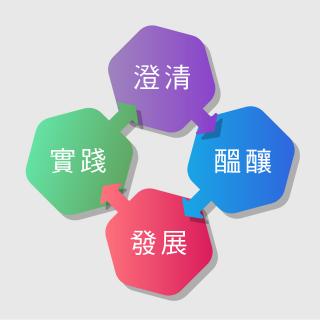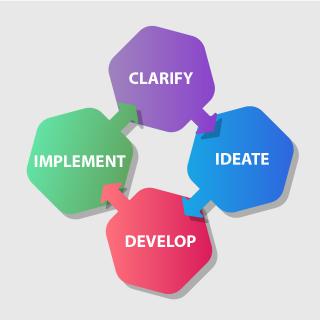透過創意解難模式培養創意學習文化
為什麼創意對我們的學生如此重要?
人類獨有思考、夢想和創造的天賦是不能取代的。創意解難是一種運用思考工具來為問題提供更具創意的解決方案的思考過程。本文提出了老師如何在日常教學中運用它來培養創意學習文化和提升學生解決問題的能力。
什麼是創意解難
「創意解難是一種解決問題或在常規思維方式失敗時尋找機會的方法」 (教學中心翻譯)(Mind Tools, 2020)。在Alex Osborn的著作Applied Imagination 中說明了兩種有助發揮創造力的獨特思維方式,分別是擴散性思考思維(用於產生大量想法)和聚斂性思考思維(用於評估選項和決策)。他強調,至關重要是要知道如何平衡擴散性和聚斂性思維,以及運用每種思維方式的時機。
創意解難流程和工具
創意解難分為四個階段,即「澄清」、「醞釀」、「發展」和「實踐」。「澄清」階段是確定目標並提出挑戰,這是問題解決者前行的必經過程。「醞釀」是指產生各種構想的階段。擁有的想法越多,解決方案就越具有創新性。然後進入第三階段─「發展」。在此階段,你可以評估和分析各項想法,從而幫助你制定更好的解決方案。在「實踐」階段,你將篩選解決方案並確定資源和行動。在每個階段,我們都執行擴散性思維(產生許多可能性)和聚斂性思維(縮小可能性)。擴散性思維是「不設限的」,其工具包括「腦震盪」、「奔馳法」和「視覺聯繫」。運用完擴散性思維模式之後就可以發揮聚斂性思維,你可以在其中評估、檢視和選擇。當中最常用的思考工具有「突出重點」、「思维共享」和「群聚圖」。

創意解難的流程
(圖像由教學中心提供,2020)
將創意解難帶入課堂
創意解難透過以解難為前題的方法來融入於學習過程。應用創意解難於課堂上的例子有以活動統籌為主題的課堂。當中,學生需要分組籌備一個於新型冠狀病毒流行期間慶祝酒店成立10週年的項目。學生先探索所面對的挑戰並釐定方向,這是創意解難裡的「澄清」階段。接下來,學生將構想一些點子(「醞釀」)以推廣酒店,例如提供特色菜單、週年活動紀念品以及餐飲和住宿優惠。在「發展」階段,學生將分析每個構思的利弊。解決了這些難題後,學生將進入「實踐」階段,他們計劃所需行動和資源,例如設定工作時間表和工作分配。在此過程中,學生可運用「腦震盪」、「視覺聯繫」、溝通和協作的工具,以理解問題及找出可行的解決方案。
結論
我們深信,只要我們能提供非批判性的有利學習環境,再配合例如創意解難這創新性和系統性的教學模式,就可以引導學生打破框架解決問題。儘管我們未必能令我們所有學生在藝術方面都具有創造力,但是我們可以培養學生通過使用思考工具想出前所未有的點子。
參考文獻:
Mind Tools. Creative Problem Solving Finding Innovative Solutions to Challenges. Retrieved June 4, 2020, from
https://www.mindtools.com/pages/article/creative-problem-solving.htm
延伸閱讀:
Yen, J. C., & Lee, C. Y. (2011). Exploring problem solving patterns and their impact on learning achievement in a blended learning environment. Computers & Education, 56(1), 138-145.
Cultivating a Creative Learning Culture through Creative Problem Solving (CPS)
Why Creativity Matters?
Our unique gift is our ability to think, to dream, and to create. Creative Problem Solving (CPS) is a thinking process that uses tools for reaching more creative solutions to problems. This article suggests how teachers can employ it in daily teaching to cultivate a creative learning culture and to enhance students' problem-solving skills.
What is Creative Problem Solving?
“Creative problem solving (CPS) is a way of solving problems or identifying opportunities when conventional thinking has failed” (Mind Tools, 2020). Alex Osborn, in his book of Applied Imagination, illustrates two distinguishing ways of thinking that contribute to being creative, namely divergent thinking (for generating lots of ideas) and convergent thinking (for evaluating options and making decisions). He stresses that it is crucial to know how to balance divergent and convergent thinking, and when to practise each of them.
The CPS Process and Tools
CPS is divided into four stages, namely “clarify”, “ideate”, “develop” and “implement”. The “clarify” stage is about identifying the goal and formulating the challenge, which is an essential process for a problem solver to move forward. The “ideate” stage refers to generating ideas. The more ideas you have, the more innovative solutions you can get. Then it moves to the third stage, “develop”. This stage allows you to evaluate and analyse the ideas, which helps you to formulate better solutions. In the implementation stage, you explore acceptance and identify resources and actions. At each stage, we execute both divergent thinking (generate many possibilities) and convergent thinking (narrow down the possibilities). Divergent thinking is “wide and free” and its tools include “brainstorming”, “scamper” and “visual connections”. Divergent thinking is followed by convergent thinking, in which you assess, evaluate and select the options. The most commonly used convergent thinking tools are “highlighting and hit”, “pair and share” and “cluster”.

4 stages of Creative Problem Solving (CPS) Process
(Image courtesy of CLT, 2020)
Bringing CPS Skills into the Classroom
CPS focuses on the process of learning by incorporating problem-centred approach. One of the examples of CPS in classroom can take place in the area of event management, where students are asked to work in groups for a project on celebrating the 10th anniversary of a hotel during the COVID-19 pandemic. For this project, students would first explore the challenge and set the principle direction which is the “clarify” stage of CPS. Next, students would generate ideas (“ideate”) for promoting the hotel, such as offering special menus, anniversary souvenirs, and dinning and recommendation packages. In the “develop” stage, students would work on analysing the pros and cons of each idea. After addressing the dilemma, students would come to the “implement” stage of CPS, in which they prepare for actions and resources, such as setting time frame and distribution of work. During the process, students comprehend the tools of brainstorming, visualisation, communication and collaboration in understanding problems and generating possible solutions.
Conclusion
It is believed that, if we provide a non-judgmental, supportive environment with an innovative and systematic thinking process like CPS, our students can be taught to think out of the box and solve problems. We may not teach all our students to be creative in terms of being artistic, but we could nurture them by using the CPS tools to think ahead of things that have not been thought of yet.
Reference:
Mind Tools. Creative Problem Solving Finding Innovative Solutions to Challenges. Retrieved June 4, 2020, from
https://www.mindtools.com/pages/article/creative-problem-solving.htm
Extended Reading:
Yen, J. C., & Lee, C. Y. (2011). Exploring problem solving patterns and their impact on learning achievement in a blended learning environment. Computers & Education, 56(1), 138-145.
